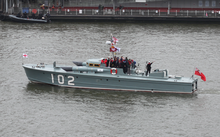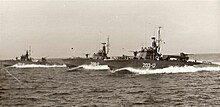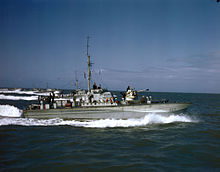Motor torpedo boat
This article needs additional citations for verification. (March 2013) |


A motor torpedo boat is a fast torpedo boat, especially of the mid 20th century. The motor in the designation originally referred to their use of petrol engines, typically marinised aircraft engines or their derivatives, which distinguished them from other naval craft of the era, including other torpedo boats, that used steam turbines or reciprocating steam engines. Later, diesel-powered torpedo boats appeared, in turn or retroactively referred to as "motor torpedo boats" for their internal combustion engines, as distinct from steam powered reciprocating or turbine propulsion.
Though other navies built similar petrol-powered craft, the specific designation "motor torpedo boat", abbreviated to "MTB", is generally used for craft of the Royal Navy (RN) and Royal Canadian Navy boats.
During the
The role of the motor torpedo boat has been absorbed in modern navies by the fast attack craft.
History

The
Specifications
Many boats were designated MTBs. A variety of designs were adopted and built. For instance, a 55 ft (17 m) type, capable of 40 kn (46 mph; 74 km/h), was shown in 1930.[3]
British MTBs
The following is an incomplete list of British motor torpedo boats:
Vosper "private venture boat"
Commander
- Length: 68 ft (21 m)
- Beam: 19 ft 9 in (6.02 m)
- Draft: 3 ft 9 in (1.14 m),
The installed powerplant of three
- Crew: 2 officers, 10 men.
Armament was two 21 in (533 mm) torpedo tubes; depth charges, machine guns and 20mm Oerlikon were trialled on her.
MTB 102 was the fastest wartime British naval vessel in service. She was at
British Power Boat 60 ft MTB
They were based on the
British Power Boat 72 ft MTB
Initially ordered as an MGB in 1941; they were converted to MTBs (412-418, 430-432, and 534-500) from 1942 by addition of two 18-inch tubes and a 6-pdr gun. Although 10 tons heavier after conversion they still made 39 knots.[8]
Vosper 45 ft MTB
Built as a private venture, the 45-ft MTBs were scaled down versions of larger Vosper design and intended to be carried by larger vessels. As MTB 104 to 107, these were taken up by Admiralty but found to be poor seakeeping and not used for combat.[9]
Vosper 70 ft MTB
Although various boat lengths were produced by Vosper for the Royal Navy, the "70 ft" boat was produced from 1940. The design was produced with modifications as MTBs 31-40, 57-66, 73-98, 222-245 and 347-362.
Using three Packard V1-12 marine engines, they were capable of around 37 kn (43 mph; 69 km/h). Early models carried two 21-inch (533 mm) torpedo tubes, twin 0.50 in (13 mm) machine guns in a "bin" behind the bridge and two 0.303 in (7.7 mm) machine guns.[10] They could also carry four depth charges.
The Vosper 70 was also used in other navies, such as Romania's, which acquired three in 1939, with NMS Viscolul the lead ship of the class.
Vosper 73 ft (Type I and Type II)
Between 1943 and 1945, the "Vosper 73ft" design appeared; this was a flush-decked type with a slight sheer forward, dispensing entirely with the low forecastle and scalloping of the majority of '70-footer' types. The type II differed from the Type I in that it carried a heavier gun armament at the expense of two torpedo tubes. Boats produced to this design carried pennant numbers MTB 380-395 and MTB 523-537. The Type II did not enter service before the end of the war but was in use after the war.[11]
- Type I
- Length: 73 ft (22 m)
- Engine: 3 Packard 4M V12 engines for a total of 4,200 hp
- Speed: 40 knots (74 km/h)
- Range: 470 nmi (870 km) at 20 knots (37 km/h)
- Displacement: 47 t
- Armament:
- Four 18-inch (457 mm) torpedo tubes
- Oerlikon 20 mm cannon
- Two 0.303 in Vickers K machine guns (optionally two Vickers .50 machine guns)
- Crew: 13
- Type II
- Length 73 ft (22 m)
- Engine 4,200 hp
- Speed 40 knots (74 km/h)
- Range 480 nmi (890 km) at 20 knots (37 km/h)
- Displacement 49 t
- Armament
- Crew 13
Thornycroft 75 ft MTB
The first two (MTB 24, 25) were actually 74 ft prototypes for the design ordered in 1938. Powered by three Isotti-Franschini engines they could reach 37 knots. The later ones, MTBs 49-56, had four Thornycroft RY12 engines but were too slow for operations.[14]
J S White 75 ft MTB
A development of the Vosper designs, White had been building under sub-contract. After construction passed to Polish Navy as S5-S10. Armed with two 18-inch torpedoes, 6-pounder gun forward, twin 20mm Oerlikon aft and two twin .303 machine gun mountings.[15]
Fairmile D MTB
The Fairmile D was a very large British MTB designed by Bill Holt and conceived by Fairmile Marine for the Royal Navy. Nicknamed "Dog Boats", they were designed to combat the known advantages of the German E-boats over previous British coastal craft designs. Larger than earlier MTB or
Canadian MTBs

These boats were designed by
Scott-Paine type G 70 foot boat
- Manufacturer: British Power Boats, Hythe
- Displacement: 55 tons
- Overall length: 72 ft 6 inches (21 m)
- Breadth: 20 ft 7 inches (6.3 m)
- Draught: 5 ft 8 inches (1.7 m)
- Maximum speed: 38–41 kn (44–47 mph; 70–76 km/h) (new)
- Armament:
- auto-loading QF 6-pounder(57mm, 2.24 inch) gun
- Two 21-inch (533 mm) torpedo tubes (two torpedoes)
- .303 or .50 Vickers machine guns
- 40 mm Bofors gun
- Powerplant – three Rolls-Royce or Packard 14M supercharged V-12 engines
three shafts - Power – 3,750 hp total
- Range – 140 nmi (260 km) radius of action at 25 kn (29 mph; 46 km/h)[17]
Post-war usage
After the end of World War II a number of Royal Navy vessels were stripped and sold for use as houseboats. These included MGBs as well as MTBs. Many of these were moored in maritime locations such as Chichester Canal (MTB 71, now restored and on display at the Royal Naval Museum in Gosport[18][19]),[20] Langstone Harbour, Littlehampton, Hayling Island and Wootton Creek, although most have now disappeared from these locations.[citation needed] More MTB houseboats can be found at Shoreham-by-Sea (West Sussex), Cobden Bridge (Southampton) and Bembridge (Isle of Wight).[21]
See also
- Battle of Rumani Coast – battle involving MTBs in Israeli-Egyptian conflict
- Coastal Forces of the Royal Navy
- E-boat
- Fairmile D motor torpedo boat – British "dog boats"
- Fast attack craft
- HNoMS Nasty
- Motor gunboat
- Motor Launch
- Operation Agreement - operation involving MTBs in WWII
- Swift boat
- United States Nasty-class patrol boat
- Wooden boats of World War 2
Notes
- ^ "Motor Torpedo Squadron ONE, Report for Pearl Harbor Attack, Naval History and Heritage Command". Archived from the original on 11 August 2020. Retrieved 29 February 2020.
- ISBN 978-1-4738-1744-9.
- ^ "Midget Torpedo Boat Has Forty-Knot Speed" Popular Science, April 1930, p. 38.
- ^ Konstam 2003, p. 22.
- ^ Harwich & Dovercourt
- ^ Konstam p6
- ^ "Fast Mosquito Boats Aid British Navy" Popular Science, December 1939
- ^ Konstam p9
- ^ Konstam p8
- ^ Konstam p15
- ^ Konstam p15
- 6-pounder anti-tank gun
- ^ Konstam p14
- ^ Konstam p8-9
- ^ Konstam p16
- ^ Konstam p17
- ^ "Naval Museum of Manitoba – Canadian Naval History". www.naval-museum.mb.ca. Archived from the original on 23 May 2018. Retrieved 12 April 2010.
- ^ Shute, Joe (3 October 2021). "Meet the last of Britain's coastal defenders, who manned the 'Spitfires of the Sea'". The Telegraph. Retrieved 27 May 2023.
- ^ "National Historic Ships UK: MTB 71". Retrieved 27 May 2023.
- ^ "Aldridge Local History: MTB 71". Retrieved 27 May 2023.
- ^ Simons, Philip; Hall, Nick (2006). Retired on the River, a Short History of the Houseboats of Shoreham (3rd ed.). World Ship Society, Small Craft Group. p. 3.
References
- Konstam, Angus (2003), British Motor Torpedo Boat 1939–45, Osprey Publishing, ISBN 978-1-84176-500-6
- Lengerer, Hans (2007). "Motor Torpedo Boats of the Imperial Japanese Navy, Part II". Warship International. XLIV (4): 345–358. ISSN 0043-0374.
- Dog Boats at War: A History of the Operations of the Royal Navy D Class Fairmile Motor Torpedo Boats and Motor Gunboats 1939–1945 by L. C. Reynolds and Lord Lewin, Sutton Pubns Inc, 2000, ISBN 978-0-7509-2454-2
External links
 Media related to Motor torpedo boat at Wikimedia Commons
Media related to Motor torpedo boat at Wikimedia Commons- A Short History of HMS St Christopher
- British Military Powerboat Team
- "Midget Torpedo Boat Has Forty-Knot Speed" Popular Science, April 1934
- Database MTB-/MGB-Battles 1940-1945. Historisches Marinearchiv (German/English)
